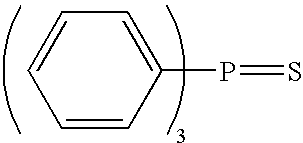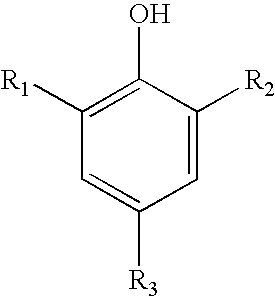Vegetable Oil Lubricating Composition
a technology of vegetable oil and lubricating composition, which is applied in the direction of lubricating composition, petroleum industry, additives, etc., can solve the problems of poor resistance to oxidative and thermal breakdown of vegetable oils,
- Summary
- Abstract
- Description
- Claims
- Application Information
AI Technical Summary
Benefits of technology
Problems solved by technology
Method used
Image
Examples
example 1
Comparative Data
[0045]Lubricating compositions were prepared using high oleic content Canola oil. Canola oil was tested without the addition of TPPT and with the addition of the phenolic antioxidant, tolutriazole derivative and ashless rust inhibitor of the invention. As expected, the addition of the additives led to significant improvement in thermal stability, oxidative stability and corrosion properties with no improvement in wear resistance. The addition of ashless antiwear additives such amine phosphates described in U.S. Pat. Nos. 4,701,273, 5,538,654 and 6,046,144, dialkyldithiophosphate esters described in U.S. Pat. No. 6,046,144 and phosphate esters improved wear resistance but for the most part did not lower wear scars to acceptable result of 0.4 mm or lower. More importantly, the more effective antiwear additives were detrimental to thermal stability and corrosion properties as summarized in Table 1.
example 2
Inventive Data
[0046]To Canola oil composition containing phenolic antioxidant, tolutriazole derivative and ashless rust inhibitor was added different concentrations of triphenylphosphorothionate (TPPT) antiwear additive. Unlike other ashless antiwear, TPPT did not negatively affect thermal stability and corrosion properties and more surprisingly, acceptable wear scars were obtained at TPPT concentrations of about 1.5 weight % as summarized in Table 2. Of more surprising significant consequence is experiment 15, which shows that acceptable wear scar, oxidative stability, thermal stability and corrosion properties are not achievable if the tolutriazole derivative is removed from the composition.
TABLE 1123456789High Oleic Content Canola Oil10099.12598.62597.62598.62597.62598.62597.62597.6252,6-di-t-butyl-p-cresol (BHT)0.650.650.650.650.650.650.650.651-[di(4-octylphenyl) aminomethyl]-tolutriazole0.1250.1250.1250.1250.1250.1250.1250.125Vanlube RI-A10.100.100.100.100.100.100.100.1C12-14-a...
PUM
| Property | Measurement | Unit |
|---|---|---|
| weight % | aaaaa | aaaaa |
| temperature | aaaaa | aaaaa |
| pressure | aaaaa | aaaaa |
Abstract
Description
Claims
Application Information
 Login to View More
Login to View More - R&D
- Intellectual Property
- Life Sciences
- Materials
- Tech Scout
- Unparalleled Data Quality
- Higher Quality Content
- 60% Fewer Hallucinations
Browse by: Latest US Patents, China's latest patents, Technical Efficacy Thesaurus, Application Domain, Technology Topic, Popular Technical Reports.
© 2025 PatSnap. All rights reserved.Legal|Privacy policy|Modern Slavery Act Transparency Statement|Sitemap|About US| Contact US: help@patsnap.com



